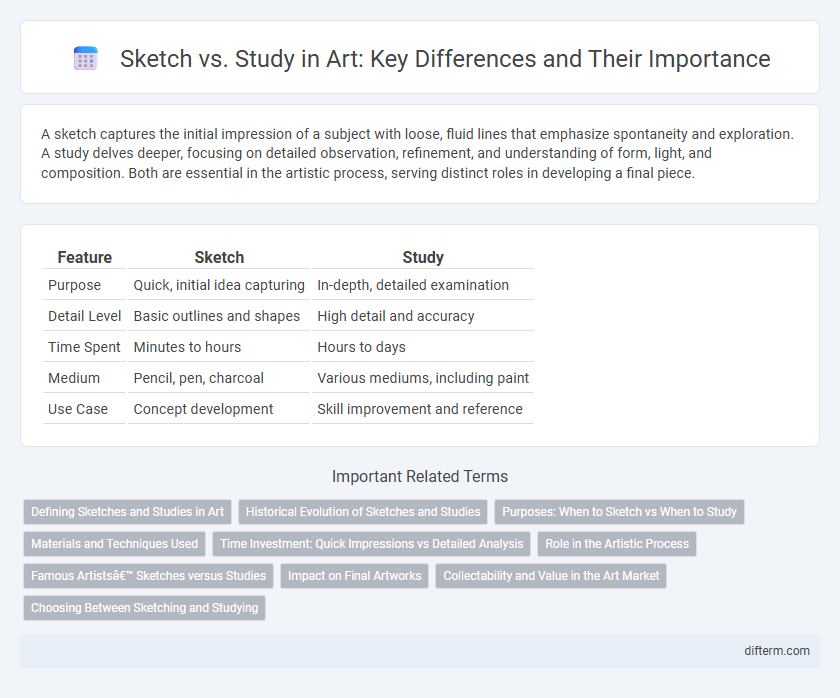A sketch captures the initial impression of a subject with loose, fluid lines that emphasize spontaneity and exploration. A study delves deeper, focusing on detailed observation, refinement, and understanding of form, light, and composition. Both are essential in the artistic process, serving distinct roles in developing a final piece.
Table of Comparison
| Feature | Sketch | Study |
|---|---|---|
| Purpose | Quick, initial idea capturing | In-depth, detailed examination |
| Detail Level | Basic outlines and shapes | High detail and accuracy |
| Time Spent | Minutes to hours | Hours to days |
| Medium | Pencil, pen, charcoal | Various mediums, including paint |
| Use Case | Concept development | Skill improvement and reference |
Defining Sketches and Studies in Art
Sketches in art are quick, informal drawings used to capture ideas, compositions, or gestures, emphasizing spontaneity and fluidity. Studies are more detailed and focused works exploring specific elements such as anatomy, lighting, or texture, aiming to prepare for a finished piece. Both serve distinct roles in the creative process, with sketches prioritizing conceptual exploration and studies emphasizing technical refinement.
Historical Evolution of Sketches and Studies
Sketches originated as quick, preliminary drawings capturing spontaneous ideas during the Renaissance, serving as essential tools for artists like Leonardo da Vinci to explore composition and form. Studies evolved from sketches into more detailed examinations of particular elements such as anatomy, light, or texture, enabling artists to refine skills and experiment with techniques before committing to final works. Over centuries, the distinction between sketches and studies highlights a progression from raw concept generation toward focused artistic practice rooted in observation and mastery.
Purposes: When to Sketch vs When to Study
Sketching serves as a quick, spontaneous way to capture initial ideas, compositions, and emotions, often used during brainstorming or outdoor observation. Studying involves a detailed, focused analysis of a subject to understand its structure, form, and nuances, typically used for skill development or preparation for a final artwork. Artists sketch to explore creativity and improvisation, while studying solidifies knowledge and refines techniques.
Materials and Techniques Used
Sketches typically use quick, loose lines with materials such as graphite pencils, charcoal, or ink to capture initial ideas and composition. Studies often involve detailed exploration using varied techniques and media, including watercolor, gouache, or layered pencil work, to refine elements like lighting, texture, and form. Both serve distinct purposes in the artistic process, with sketches prioritizing spontaneity and studies emphasizing depth and accuracy.
Time Investment: Quick Impressions vs Detailed Analysis
Sketches capture quick impressions with minimal time investment, allowing artists to explore composition and form rapidly. Studies demand detailed analysis and extended focus, involving careful observation and refinement of elements such as light, texture, and anatomy. Time investment in studies results in higher accuracy and depth, while sketches prioritize spontaneity and conceptual development.
Role in the Artistic Process
A sketch serves as a quick, spontaneous visual idea, capturing the basic structure and composition, while a study is a more detailed and refined examination of specific elements such as light, texture, or anatomy. Sketches provide the foundational groundwork for creative exploration and experimentation, facilitating rapid iteration of concepts. Studies deepen understanding and inform the final artwork by resolving challenges and enhancing accuracy within the artistic process.
Famous Artists’ Sketches versus Studies
Famous artists' sketches often capture raw, spontaneous ideas and gestures, serving as initial creative sparks, while their studies provide detailed exploration and refinement of form, light, and anatomy. Sketches by Leonardo da Vinci reveal his rapid thought process and inventive concepts, contrasting with his studies that meticulously analyze human anatomy and motion. These two artistic practices collectively highlight an artist's evolving vision from rough drafts to polished understanding.
Impact on Final Artworks
Sketches capture initial ideas with loose lines and minimal detail, serving as a quick visual brainstorming tool. Studies delve deeper into elements like anatomy, lighting, or composition, refining specific components to enhance accuracy and expressiveness. Investing time in thorough studies results in more polished and cohesive final artworks, as artists build a solid foundation for complex designs.
Collectability and Value in the Art Market
Sketches often serve as preliminary explorations, valued for their raw spontaneity and insight into the artist's creative process, attracting collectors who appreciate authenticity and developmental stages. Studies, typically more refined and detailed, hold greater collectability due to their closer representation of the final artwork and higher market demand among serious investors. The art market assigns distinct value to sketches and studies based on rarity, artist reputation, and historical significance, with studies generally commanding higher auction prices.
Choosing Between Sketching and Studying
Choosing between sketching and studying depends on artistic goals and desired outcomes. Sketching emphasizes rapid, expressive mark-making to capture initial ideas or compositions, serving as a spontaneous visual brainstorming process. In contrast, studying involves detailed observation and analysis of subjects to improve technique and deepen understanding, making it essential for skill development and refinement.
Sketch vs Study Infographic

 difterm.com
difterm.com